The Core i7 980X Review: Intel's First 6-Core Desktop CPU
by Anand Lal Shimpi on March 11, 2010 12:00 AM EST- Posted in
- CPUs
It’s rare that anything we review has the longevity that Intel’s Core i7 Bloomfield platform has enjoyed. If you were one of the fortunate few to buy a Core i7 920, 940 or 965 back in November 2008, you’d still have one of the fastest desktop CPUs today in March 2010.
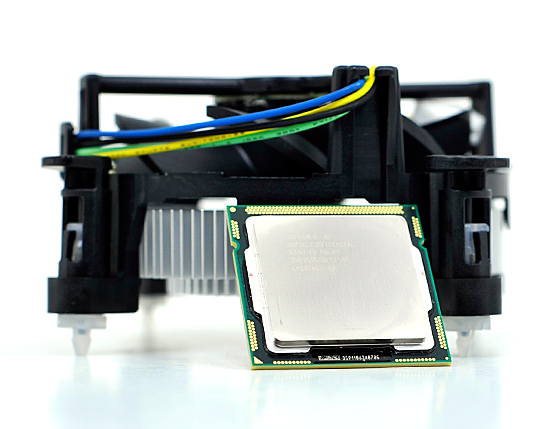
Lynnfield was introduced in 2009, but still couldn't dethrone Bloomfield.
In fact, other than a few minor speed bumps, Intel hasn’t done much with its LGA-1366 platform in the past 15 months. Last year Intel introduced Nehalem for the rest of us with its LGA-1156 socket and in January we got the first dual-core derivatives.
Now it’s finally time to take care of the folks who invested in Nehalem and Core i7 early on. In the coming weeks Intel will be shipping its first 6-core desktop processor, built using the same 32nm process used in the Clarkdale Core i3/i5 CPUs. It’s codenamed Gulftown but today we can call it the Core i7 980X. Did I mention that with a BIOS update it’s fully compatible with all X58 motherboards? That’s right, even if you bought a board in November 2008 - you can upgrade directly to Gulftown.
| Processor | Core Clock | Cores / Threads | L3 Cache | Max Turbo | TDP | Price |
| Intel Core i7 980X | 3.33GHz | 6 / 12 | 12MB | 3.60GHz | 130W | $999 |
| Intel Core i7 975 | 3.33GHz | 4 / 8 | 8MB | 3.60GHz | 130W | $999 |
| Intel Core i7 960 | 3.20GHz | 4 / 8 | 8MB | 3.46GHz | 130W | $562 |
| Intel Core i7 930 | 2.80GHz | 4 / 8 | 8MB | 3.06GHz | 130W | $284 |
| Intel Core i7 870 | 2.93GHz | 4 / 8 | 8MB | 3.60GHz | 95W | $562 |
| Intel Core i7 860 | 2.80GHz | 4 / 8 | 8MB | 3.46GHz | 95W | $284 |
| Intel Core i5 750 | 2.66GHz | 4 / 4 | 8MB | 3.20GHz | 95W | $196 |
| Intel Core i5 670 | 3.46GHz | 2 / 4 | 4MB | 3.73GHz | 73W | $284 |
| Intel Core i5 661 | 3.33GHz | 2 / 4 | 4MB | 3.60GHz | 87W | $196 |
| Intel Core i5 660 | 3.33GHz | 2 / 4 | 4MB | 3.60GHz | 73W | $196 |
| Intel Core i5 650 | 3.20GHz | 2 / 4 | 4MB | 3.46GHz | 73W | $176 |
| Intel Core i3 540 | 3.06GHz | 2 / 4 | 4MB | N/A | 73W | $133 |
| Intel Core i3 530 | 2.93GHz | 2 / 4 | 4MB | N/A | 73W | $113 |
| Intel Pentium G9650 | 2.80GHz | 2 / 2 | 3MB | N/A | 73W | $87 |
The Entire 2010 Nehalem/Westmere lineup
In fact, that’s exactly what I did for today’s review. This is Intel’s DX58SO motherboard I used in my original Core i7 review in November 2008:
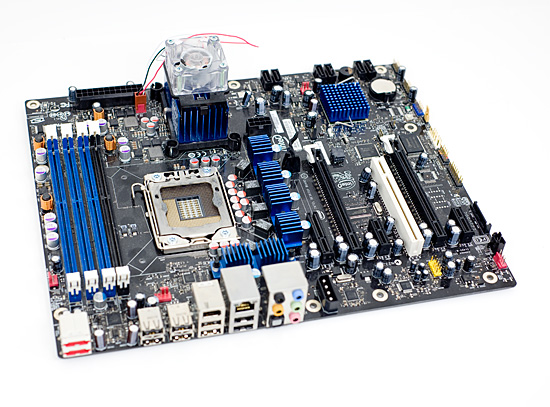
It’s the same exact board, but updated to the 5020 BIOS that’s currently available on Intel’s site. Intel was sneaky and actually enabled Gulftown support in its motherboards a few weeks ago.
And here we have the result:
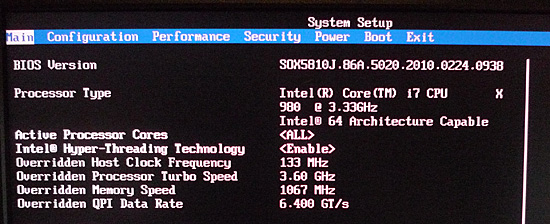
Intel’s Core i7 980X, running at 3.33GHz with 6 cores, 12 threads and a massive 12MB L3 cache all running on a motherboard that shipped a year and a half ago.

The old board works mostly fine with the 980X but with some odd bugs and quirks that I ran into. I found that my older DDR3-1066 memory wouldn't overclock to 1333MHz with Gulftown, although it did just fine with Bloomfield for some reason.
It’s not just Intel enabling support either. All motherboard manufacturers either have or are expected to have BIOSes with Gulftown support by the time this chip ships in the coming weeks. ASRock sent over its X58 Extreme, which worked perfectly with the new chip:
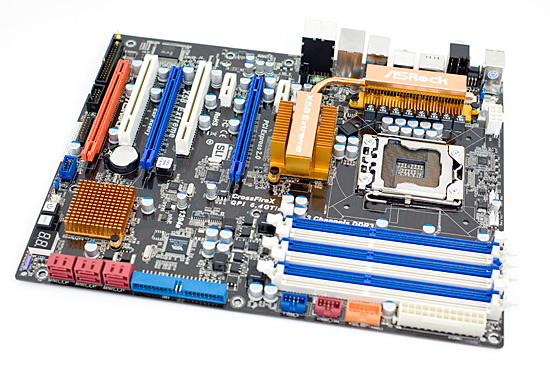
It’s Extreme
The coolest part of Gulftown is that by building it on Intel’s 32nm process it’s actually smaller than both Bloomfield and Lynnfield, despite having 50% more cores and L3 cache:
| CPU | Codename | Manufacturing Process | Cores | Transistor Count | Die Size |
| Westmere 6C | Gulftown | 32nm | 6 | 1.17B | 240mm2 |
| Nehalem 4C | Bloomfield | 45nm | 4 | 731M | 263mm2 |
| Nehalem 4C | Lynnfield | 45nm | 4 | 774M | 296mm2 |
| Westmere 2C | Clarkdale | 32nm | 2 | 384M | 81mm2 |
| AMD Phenom II X4 | Deneb | 45nm | 4 | 758M | 258mm2 |
At 1.17 billion transistors, it’s a beefy chip but the monolithic die only measures 240mm^2. It’s even smaller than an AMD Phenom II X4. Not only does it have a smaller die than all quad-core Nehalem processors, but it also has the same TDP.
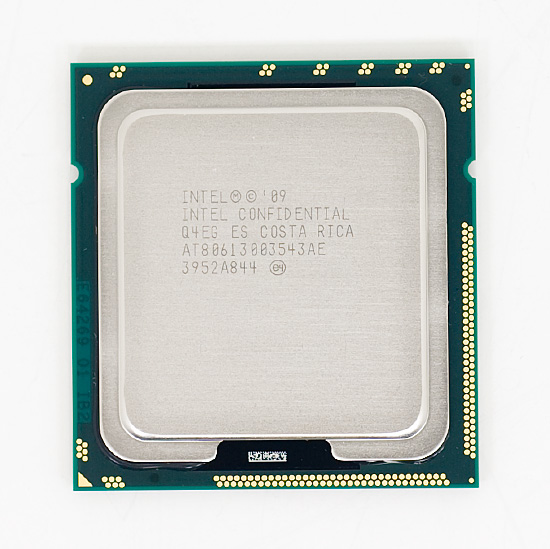
The 130W chip runs at 3.33GHz, but because of the high TDP it can only turbo up to 3.46GHz with more than two cores active. If only one or two cores are active, the chip can turbo up to 3.60GHz. With up to 6 cores running at 3.46GHz, Gulftown is not only the fastest CPU in Intel’s lineup, it’s also the fastest quad-core Intel makes. Only the Core i5 670 can run at a higher frequency with a single core active (3.73GHz vs 3.60GHz).
The downside to all of this is the price tag. The Core i7 980X is an Extreme Edition processor, meaning it’s introduced at the $999 price point. And currently it’s the only way to get 6-cores in a Core i7. Currently Intel doesn't have any plans to introduce 4-core versions of Gulftown on the desktop, although we will see some 32nm quad-core Xeons later this year.
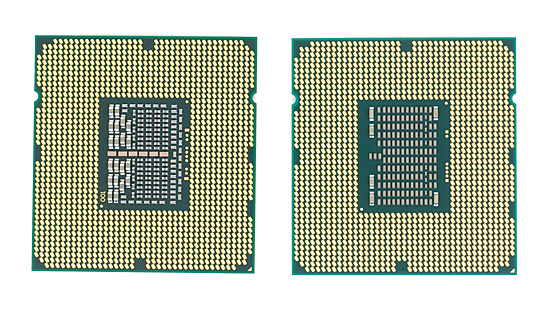
Bloomfield (left) vs. Gulftown (right)
This isn’t the first time that the $999 price tag comes with some exclusive features. The first Pentium 4 Extreme Edition was the very first to wear the EE brand. While all regular Pentium 4s at the time had a 512KB L2, the Pentium 4 Extreme Edition added a 2MB L3 cache - a feature that never trickled down to the mainstream P4s.
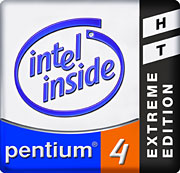
Since then, most Extreme Edition parts have just been higher clocked CPUs. Despite that, they do sell well enough for Intel to continue the practice. Given that this time around, the Core i7 980X will not only give you clock speed but more cores and cache, Intel will probably end up selling more of these than they ever have.










102 Comments
View All Comments
LoneWolf15 - Thursday, March 11, 2010 - link
[QUOTE]With up to 6 cores running at 3.46GHz, Gulftown is not only the fastest CPU in Intel’s lineup, it’s also the fastest quad-core Intel makes.[/QUOTE]I think you meant to say it's also the fastest "single-core" Intel makes.
yacoub - Thursday, March 11, 2010 - link
And for only one thouuuuusand dollars! What a deal!!
lol yeah, anyone who spent $999 on an X58 CPU can now spend $999 on a new cpu 18 months later. $2000 for two CPUs in the course of 18 months. How you can spin that as being a good thing boggles the mind. What a waste!
strikeback03 - Thursday, March 11, 2010 - link
Well, maybe you spent the ~$280 or so on a 920 in November 08, which you could now upgrade to the 980X if you wanted. Considering Intel's past history of supporting new processors on older motherboards (see, for example, P965 and Penryn) it is nice that this is supported, even if the upgrade is extremely expensive.BelardA - Thursday, March 11, 2010 - link
Kinda sad and funny... when core 2 came out, it destroyed the P4 line and of course kicked AMD down bad.Even todays $65 intels and $45 AMDs (running about 2ghz) are still faster than those older Pentium EE chips. And what was sadder back then was that even AMD's $200 CPUs were still faster than the $1000 intels... unless your were doing 3D work and encoding video.
*sigh*
Thanks to intel's back-room deals with the major PC companies, the illegal activities has hurt competition. AMD is doing better today, but have little to work with. And we see what the lack of competition does such as ATI vs. Nvidia.
andyleung - Thursday, March 11, 2010 - link
Why they keep the CPU frequency so high? All consumer quad cores go higher than 2.5GHz??? I really like Opterons, low frequency with more cores.Seriously I hope Phenom VI (I made it up, they may call it something else) could have a model of 6 cores with each running 1.2GHz.
My own usage is mostly programming in JEE + documentation, so I need more cores but not that fast, so I could save a few bucks on my electricity bill in a year. :)
yuchai - Thursday, March 11, 2010 - link
You can always underclock/undervolt if you don't need the performance from the extra speed but want the power savings.Note that this is the "Extreme" version, so it makes sense to have the fastest speeds possible. The mainstream versions that are coming will probably have lower clock speeds.
at80eighty - Thursday, March 11, 2010 - link
Maybe I missed it - but would this have any predicted implications on the 920 price over this year span?I'm rebuilding a rig a component at a time and Im wondering if there would be much variance if I picked a 920 now or in Q4
/tard
IntelUser2000 - Thursday, March 11, 2010 - link
"The first Core i7 did not power gate its L3 cache, Lynnfield added it and Gulftown has it as well."THANK YOU ANAND!!
No wonder this is my #1 favored site. :D
darkhawkff - Thursday, March 11, 2010 - link
I don't know about anyone else, but I would have liked to have seen how this chip fares to overclocks of Intel's other Core i7 series. While I'm sure many people don't bother overclocking, I would wager that most people who visit this site do, and probably bought into the Core i7 920 series and overclocked it to 4 GHz or more. While I'm sure the Core i7 980X is a beast, I'd be more interested in seeing how it fares when overclocked parts are taken into account, because personally I see very little reason to make the jump from the 920 to the 980 after this review. 2 more cores are nice, but not when they are slower.B3an - Thursday, March 11, 2010 - link
Anand, can you please include newer software for some benches. For instance you are still using 3DS Max 9 which was released in 2006.The latest is 3DS MaX 2010 (version 12).
I only ask because i'm sure that anyone who can afford this CPU can ceratinly afford the latest 3D rendering/modelling software. And besides that they might have better support/performance for these type of CPU's.